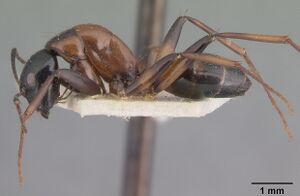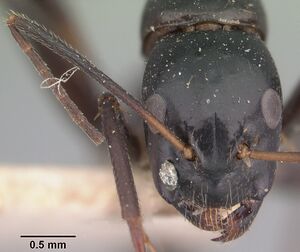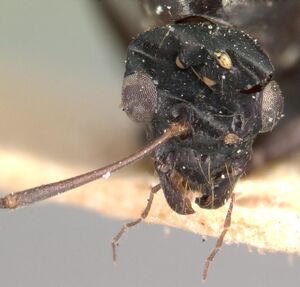Camponotus dromedarius
| Camponotus dromedarius | |
|---|---|

| |
| Scientific classification | |
| Kingdom: | Animalia |
| Phylum: | Arthropoda |
| Class: | Insecta |
| Order: | Hymenoptera |
| Family: | Formicidae |
| Subfamily: | Formicinae |
| Tribe: | Camponotini |
| Genus: | Camponotus |
| Subgenus: | Mayria |
| Species: | C. dromedarius |
| Binomial name | |
| Camponotus dromedarius Forel, 1891 | |
Camponotus dromedarius is only known from Madagascar. Members of the species have been found mostly at altitudes between 800–1400 m in the central region, relict montane rainforest in the central west, and eastern montane rainforests. The species nests in rotten logs and rotting tree stumps and forages on the ground and low vegetation in these habitats.
Identification
A member of the subgenus Mayria (see diagnosis). Rakotonirina and Fisher (2018) - Median portion of clypeus not longitudinally carinate; mandible with six teeth; in lateral view, mesosoma short and high, its dorsal outline continuously arched in a dome-like structure; propodeal declivity inclined posteriorly; in lateral view, propodeal dorsum straight, without excision; petiolar node higher than long; anterior clypeal margin broadly convex.
Members of C. dromedarius can be separated from similar species in the group such as Camponotus pulcher and Camponotus lamosy by its larger body size (CL: 1.19–1.84), the straight propodeal dorsum, and the higher than long petiolar node. It can be distinguished from other species by the absence of a median longitudinal carina on its clypeus, the dome-like structure of its mesosoma, and the generally black body color which occasionally has a dark brown mesosoma with orange spots.
Keys including this Species
Distribution
Latitudinal Distribution Pattern
Latitudinal Range: -13.5888° to -24.85°.
| North Temperate |
North Subtropical |
Tropical | South Subtropical |
South Temperate |
- Source: AntMaps
Distribution based on Regional Taxon Lists
Malagasy Region: Madagascar (type locality).
Distribution based on AntMaps
Distribution based on AntWeb specimens
Check data from AntWeb
Countries Occupied
| Number of countries occupied by this species based on AntWiki Regional Taxon Lists. In general, fewer countries occupied indicates a narrower range, while more countries indicates a more widespread species. |

|
Estimated Abundance
| Relative abundance based on number of AntMaps records per species (this species within the purple bar). Fewer records (to the left) indicates a less abundant/encountered species while more records (to the right) indicates more abundant/encountered species. |

|
Biology
Castes
Worker
Minor
Images from AntWeb
   
| |
| Worker. Specimen code casent0496817. Photographer Erin Prado, uploaded by California Academy of Sciences. | Owned by CAS, San Francisco, CA, USA. |
   
| |
| Worker. Specimen code casent0101107. Photographer April Nobile, uploaded by California Academy of Sciences. | Owned by NHMB, Basel, Switzerland. |
    
| |
| Worker. Specimen code casent0101538. Photographer April Nobile, uploaded by California Academy of Sciences. | Owned by MHNG, Geneva, Switzerland. |
Major
Images from AntWeb
   
| |
| Paralectotype of Camponotus dromedarius. Worker. Specimen code casent0101531. Photographer April Nobile, uploaded by California Academy of Sciences. | Owned by MHNG, Geneva, Switzerland. |
  
| |
| Lectotype of Camponotus dromedarius. Worker. Specimen code casent0101534. Photographer April Nobile, uploaded by California Academy of Sciences. | Owned by MHNG, Geneva, Switzerland. |
Male
Images from AntWeb
   
| |
| Paralectotype of Camponotus dromedarius. Male (alate). Specimen code casent0101422. Photographer April Nobile, uploaded by California Academy of Sciences. | Owned by MNHN, Paris, France. |
Nomenclature
The following information is derived from Barry Bolton's Online Catalogue of the Ants of the World.
- dromedarius. Camponotus dromedarius Forel, 1891b: 65, pl. 2, fig. 5 (s.w.m.) MADAGASCAR.
- Combination in C. (Myrmocamelus): Forel, 1914a: 270;
- combination in C. (Myrmosaga): Emery, 1920b: 257;
- combination in C. (Mayria): Emery, 1925b: 122.
- Status as species: Dalla Torre, 1893: 229; Emery, 1896d: 374 (in list); Wheeler, W.M. 1922a: 1045; Emery, 1925b: 122; Bolton, 1995b: 97; Rakotonirina & Fisher, 2018: 25 (redescription).
Unless otherwise noted the text for the remainder of this section is reported from the publication that includes the original description.
Description
Worker
Rakotonirina and Fisher (2018) - Minor. In full-face view, head longer than broad (CWb/CL: 0.80±0.07; 0.72–1.05), lateral margins roughly straight and slightly converging anteriorly; posterior margin more or less straight. Anteromedian clypeal margin straight with broadly convex lateral angle. Eyes not breaking lateral outlines of head, their posterior margins located well behind the mid-length of the head (PoOc/CL: 0.34±0.02; 0.31–0.39). Mandible triangular, masticatory margin with six sharp teeth. Antennal scape long, roughly its distal half extending beyond posterior cephalic border. In lateral view, mesosoma evenly convex, its dorsal outline continuously arched in a dome-like structure; pronotum with anterodorsal margin; pronotum and mesonotum separated by a shallow, broad angle; junction of propodeal dorsum and declivity round. Petiolar node higher than long.
Whitish, erect, filiform hairs abundant and pubescence present on dorsum of head, mesosoma, petiolar node, and gastral segments. Body color generally black or mesosoma dark brown with orange spots.
Major. Characteristics the same as minor worker, except the enlarged head (CS: 1.64±0.12; 1.48– 1.82; CWb/CL: 0.93±0.04; 0.86–0.98); the more strongly built mandible; apical third of antennal scape surpassing posterior cephalic margin; metanotum visible; propodeal dorsum convex and its junction to declivity broadly angulate; petiolar node much higher than long.
Type Material
- Lectotype (designated by Rakotonirina & Fisher, 2018: 25), minor worker, Imerina et environs d’Antananarivo, Forêt d’Analamainty, Madagascar, Camboué, CASENT0101534, Musee d'Histoire Naturelle Genève; ex bamboo internodium.
- Lectotype (designated by Rakotonirina & Fisher, 2018: 25), worker, Imerina et environs d’Antananarivo, Forêt d’Analamainty, Madagascar, Camboué, CASENT0101531, Musee d'Histoire Naturelle Genève; ex bamboo internodium.
- Lectotype (designated by Rakotonirina & Fisher, 2018: 25), male, Imerina et environs d’Antananarivo, Forêt d’Analamainty, Madagascar, Camboué, CASENT0101422, Musee National d'Histoire Naturelle; ex bamboo internodium.
References
- Bolton, B. 1995b. A new general catalogue of the ants of the world. Cambridge, Mass.: Harvard University Press, 504 pp. (page 97, catalogue)
- Emery, C. 1920b. Le genre Camponotus Mayr. Nouvel essai de la subdivision en sous-genres. Rev. Zool. Afr. (Bruss.) 8: 229-260 (page 257, combination in C. (Myrmosaga))
- Emery, C. 1925d. Hymenoptera. Fam. Formicidae. Subfam. Formicinae. Genera Insectorum 183: 1-302 (page 122, combination in C. (Mayria))
- Forel, A. 1891c. Les Formicides. [part]. In: Grandidier, A. Histoire physique, naturelle, et politique de Madagascar. Volume XX. Histoire naturelle des Hyménoptères. Deuxième partie (28e fascicule). Paris: Hachette et Cie, v + 237 pp. (page 65, pl. 2, fig. 5 worker, male described)
- Forel, A. 1914a. Le genre Camponotus Mayr et les genres voisins. Rev. Suisse Zool. 22: 257-276 (page 270, combination in C. (Myrmocamelus))
- Rakotonirina, J.C., Fisher, B.L. 2018. Taxonomic revision of the Malagasy Camponotus subgenus Mayria (Hymenoptera, Formicidae) using qualitative and quantitative morphology. Zootaxa 4438: 1–58 (DOI 10.11646/zootaxa.4438.1.1).
- Wheeler, W. M. 1922k. Ants of the American Museum Congo expedition. A contribution to the myrmecology of Africa. IX. A synonymic list of the ants of the Malagasy region. Bull. Am. Mus. Nat. Hist. 4 45: 1005-1055 (see also)
References based on Global Ant Biodiversity Informatics
- Emery C. 1886. Saggio di un catalogo sistematico dei generi Camponotus, Polyrhachis e affini. Memorie della Reale Accademia delle Scienze dell'Istituto di Bologna 5: 363-382
- Fisher B. L. 1997. Biogeography and ecology of the ant fauna of Madagascar (Hymenoptera: Formicidae). Journal of Natural History 31: 269-302.
- Fisher B. L. 2003. Formicidae, ants. Pp. 811-819 in: Goodman, S. M.; Benstead, J. P. (eds.) 2003. The natural history of Madagascar. Chicago: University of Chicago Press, xxi + 1709 pp.
- Rakotonirina J. C., and B. L. Fisher. 2018. Taxonomic revision of the Malagasy Camponotus subgenus Mayria Hymenoptera, Formicidae) using qualitative and quantitative morphology. Zootaxa 4438: 1-58.

